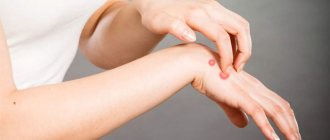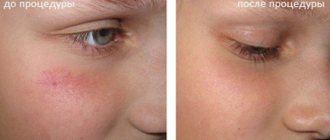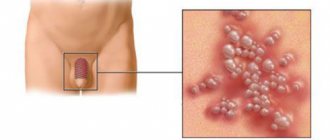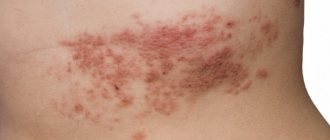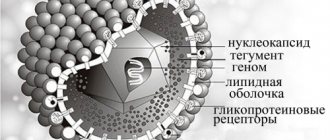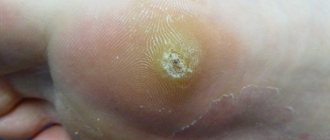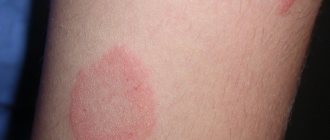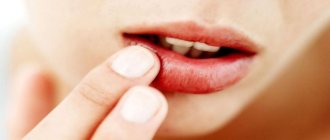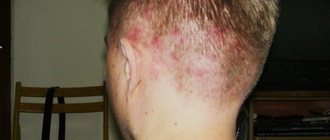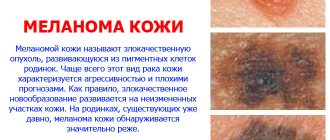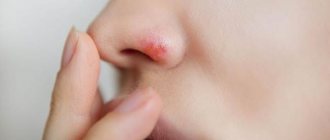Causes
Herpes
Herpes
Herpes simplex infection tends to affect the lower back and buttocks. The rash due to herpes usually appears as small blisters or sores around the nose, mouth, lower back, genitals, and buttocks. The virus is highly contagious and is spread by direct contact with skin lesions. Treatment includes:
- Ibuprofen, which may help stop fever, pain, and muscle soreness caused by the virus
- Wearing loose clothing to minimize skin irritation
- Applying a warm compress or ice pack to relieve swelling and discomfort.
Dühring's dermatitis herpetiformis
Dermatitis herpetiformis
Dermatitis herpetiformis is a rare but persistent disease that is often associated with intolerance to gluten (the protein in flour), although its causes are not fully known. Lesions can usually appear on the scalp, shoulders, buttocks, elbows and knees. They present as extremely itchy, often seven-fold clusters of blisters, sores or spots on the body. Men encounter this disease twice as often, although girls under the age of 20 suffer from it more often.
Dermatitis herpetiformis usually has a good prognosis and responds well to a strict gluten-free and drug-free diet. As a drug treatment, dapsone is the drug of choice if diet does not help.
Friction
Friction is a common cause of skin blisters. This is common for people who lead an active lifestyle, including sports players. Chafing can be caused by clothing that creates friction on the skin in the genital area, lower back and buttocks.
Moist skin around the groin and buttocks can increase the risk of developing blisters. They are found in places where intense friction occurs.
Skin reaction to external factors
The skin reaction can cause ulcers and blisters, for example, when it comes into contact with excessive heat, such as a sunburn.
Infections
Impetigo is a bacterial skin lesion that manifests itself in the form of spots, then bursting blisters and ulcers.
Children suffer much more often . Viral or fungal infections can cause skin problems in the buttocks area. These include chickenpox, impetigo, shingles and others.
Allergic reactions
An allergic reaction such as eczema may also cause blisters to form. In this case it is usually caused by an allergy to chemicals.
Medications
Some medications (for example, nalidixic acid) can cause sores.
Prevention of re-exacerbation
There are no ways to permanently get rid of herpes on the butt, because the disease is chronic. Prevention plays an important role in the treatment of the disease, helping to prolong remission and mitigate relapses.
If a person is tormented by herpes on his butt, he must first reconsider his lifestyle: reduce alcohol consumption, quit smoking, watch his diet.
The frequency and intensity of recurrences of herpes on the buttocks depends on the characteristics of the body, so you should strengthen your immune system, follow hygiene rules, lead an active lifestyle and avoid unprotected sexual contact, especially when it comes to relationships with unfamiliar people.
Blisters between the buttocks
The presence of a rash may be the main cause of blisters between the buttocks. This part of the body is prone to developing blistering rashes. Reasons include:
- Infections such as impetigo, staph bacteria, herpes, chicken pox and others
- Skin diseases such as dermatitis, epidermolysis
- Medications
- Allergies
- Intense friction of the skin between the buttocks
- Skin irritation.
Blisters between the buttocks can be painful depending on what is causing them. The duration of the rash depends on the underlying causes. While they can sometimes go away on their own within a few days, blisters caused by infection can remain for weeks or months.
Chronic problems may require long-term treatment to get rid of them (for example, the herpes simplex virus).
Diagnostics
It is not recommended to make a diagnosis yourself, comparing your symptoms with photos of other people’s pathologies, or using a forum for this. It is recommended to trust your physician or infectious disease specialist to find out why the rash appears.
The doctor conducts a general examination, identifying the presence of bubbles with transparent contents. This indicates a viral disease.
Gluteal herpes and its type are determined based on laboratory tests:
- general clinical examination of urine and blood;
- ELISA (enzyme-linked immunosorbent assay) - determines the type and number of antibodies produced to a specific type of virus;
- PCR is an accurate determination of the type of virus when its genetic material is detected; the method is informative and reflects the true results even with a small amount of biological material.
Material for analysis is obtained by removing blood and scraping tissue.
Ulcers
The skin in the buttock area is susceptible to infections, which may be difficult to notice. An infection of the hair follicles (folliculitis) usually goes away on its own without treatment. But it can also spread, causing boils that will require antibiotics.
Often the problem concerns people who are bedridden. The sores can become quite severe, resulting in ulceration and a large area of affected skin on the buttocks. A number of reasons that can lead to buttock ulcers include:
- Skin diseases, including various rashes
- Genital herpes
- Impetigo
- Allergic reactions
- Eczema
- Shingles
- Infections.
Symptoms
Symptoms in adults and children are similar. The patient develops characteristic clinical symptoms of lumbar herpes, by which the doctor determines the presence of pathology:
- herpes between the berries forms small bubbles with transparent contents, which are filled with liquid containing the pathogen;
- uncomfortable sensations are formed - itching, burning, pain (they intensify during walking, defecation);
- gradually the rash spreads to the outer area of the buttocks and genitals;
- malaise (weakness, fatigue, lethargy, drowsiness);
- intoxication of the body, manifested in joint pain, increased body temperature;
- enlargement of local lymph nodes near the lesion.
Based on how the patient’s buttock area looks, the doctor assumes intergluteal herpes, but the diagnosis can be confirmed based on diagnostic tests.
Treatment
Blisters and sores may heal on their own. You need to leave them alone. Squeezing the blisters may increase the chance of infection.
Protect the blister
Blisters tend to protect the skin, so you shouldn't pop them as this can increase the risk of infection. Instead, cover the blisters with a bandage or bandage until they go away on their own. The idea is that the liquid they contain is reabsorbed and the skin smooths out naturally.
Large or painful blisters may be popped and an antibacterial cream should be applied to prevent the risk of infection.
Over-the-counter pharmaceuticals
You need to use topical medications with an antibiotic to treat the problem. Antibiotic creams or tablets can be used for impetigo. Antibiotics are usually recommended to treat infected sores.
Corticosteroids/immunosuppressive drugs
Blisters caused by dermatitis herpetiformis can be treated with injections of corticosteroids or immunosuppressants.
Loose underwear
Although most blisters will heal naturally anyway, wearing loose-fitting underwear is recommended to help reduce skin irritation. Skin irritation and friction are common causes of blisters around the genitals and buttocks.
You can use Neosporin or a similar ointment to help the healing process.
Non-communicable diseases
What do you need to know about them? Non-infectious diseases can occur at any age.
These include:
- Psoriasis: is the result of a disorder of the immune system. Foci of the disease can cause pain and discomfort.
- Dermatitis: one of the most common manifestations. It can occur as a result of an allergic reaction to external irritants: insect bites, chemicals, cosmetics, medications, pollen, including poisonous ones.
- Urticaria: a distinctive feature of this disease is the presence of two stages of development. First, itching may appear on one area of the body. After some time, blisters appear on the surface of the skin. Hives are the body's reaction to allergies of any nature.
- Pimples and ulcers: the cause of this problem lies in Staphylococcus aureus. If you do not pay attention to these manifestations, then over time they can turn into boils.
Home Remedies
Warm compress
It will help reduce inflammation, pain and speed up the healing process.
- Soak a clean piece of cloth or cotton swab in warm water
- Gently apply to affected area
- Wait a while, about 2 minutes
- Repeat the procedure several times.
Aloe vera
Aloe vera gel is a natural soothing remedy that treats skin inflammation, including blisters.
- Cut a fresh aloe leaf
- Scoop out the gel-like pulp
- Apply it gently to the affected area
- Let it dry, then rinse with warm water
- Repeat this procedure 2 - 3 times a day.
Garlic
Garlic has antibacterial and antifungal properties. This is a natural remedy to cure blisters on buttocks at home.
- Crush the garlic cloves into a paste
- Apply paste to blisters
- After 20 minutes, rinse skin with warm water
- To achieve the best results, repeat the manipulations 2 - 3 times a day for a couple of weeks.
Baking soda
- Add a teaspoon of baking soda to water
- Make a thick paste
- Apply it on the ulcers on the buttocks
- Leave for 10-15 minutes, then rinse with warm water
- Repeat the procedure for several days.
Neem oil
Margosa or neem is considered a natural cure for many skin diseases. The oil has both antifungal and antiseptic properties.
- Dip a cotton swab into the oil
- Apply it to the affected area
- Leave for about 5 - 10 minutes, then rinse
- Carry out this procedure for several days.
Turmeric powder
Turmeric has antiseptic, anti-inflammatory and antioxidant properties. The paste, when applied to a blister, can speed up the healing process in a couple of days.
- Cleanse skin with warm water
- Mix a teaspoon of turmeric powder with a cup of water and make a paste
- Apply it to the problem area and cover with a bandage
- Repeat the manipulations three times a day for several days.
Why does a newborn baby's bottom turn red and itch very much?
If your baby's bottom is red, this manifestation should be taken very seriously. This phenomenon causes great discomfort to the child. It is imperative to understand the cause of redness. It can manifest itself as a consequence of the disease, or due to inattention on the part of parents. A baby’s bottom may itch and turn red in the following cases:
- The development of heat rash is a phenomenon that occurs due to the fact that sweat production increases, but something prevents its evaporation. The child develops small blisters that cause severe itching.
- Diaper rash caused by excess moisture, friction or poor hygiene.
- Skin dermatitis of allergic origin - urticaria. It can be caused not only by diapers, but also by creams, powders, and medications.
- Remains of feces on the baby's bottom. This is a common occurrence that occurs with loose stools.
Many mothers begin to confuse irritation on the butt with an allergy. This is a very serious mistake. Allergies are not concentrated in one place, but spread throughout the body.
Redness under the diaper - Dr. Komarovsky
What to do about pimples and a red bottom in a child?
If a child has a red bottom, it is important for parents to realize that proper care is needed to get rid of the problem. Since a pimple or rash will be very irritating to the baby, he will want to scratch the affected area. It is necessary to avoid scratching, as this will spread the infection and lead to the formation of ulcers and wounds.
Often, in complex therapy, doctors recommend giving the child baths with soothing herbs. But it is important that the child is not allergic to the plant. To eliminate gluteal dermatitis, you can use:
- Add a little tooth powder and potassium permanganate to the bathing water. This will help dry out the skin a little.
- Diaper rash can be lubricated with vegetable or olive oil, which is pre-boiled in a water bath.
- If a child scratches a spot, you can treat the affected area with a soda solution.
- At home, you can prepare a decoction of oak bark, string and calendula. The mixture of herbs must be poured with water and boiled for ten minutes.
Sunbathing helps get rid of irritation well. But you need to be very careful with them to prevent burns.
Why does the baby have a red bottom? What to do?
